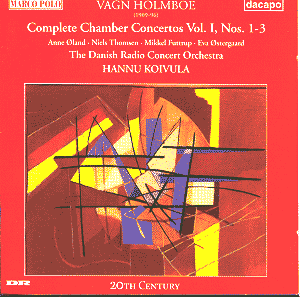|
Vagn HOLMBOE (1909-96) |
 |
Since his death some five years ago Holmboe has been recognised as standing as a successor to Nielsen in the Danish (and probably the wider Scandinavian) pantheon.
His music has yet to travel on the same scale as Nielsen's but these are early days yet. BIS have done more for him than any other company. All the symphonies and half a dozen other discs including choral works, concertos and piano music are available from Robert von Bahr's company - some of it stretching back to the company's pristine analogue past.
Da Capo are no less dedicated to the cause. To have recorded all the string quartets (18?), all the chamber concertos and the first of two discs gathering the Sinfoniettas is no mean achievement.
The thirteen chamber concertos were written from 1939 to 1956. Rather like the similarly numerous Malcolm Arnold concertos each was inspired by a specific soloist and is tied up with that soloist's character.
Five of the concertos are for multiple soloists. One (No. 8) is a concerto for orchestra. There are concertos for solo: piano, clarinet, viola, violin, oboe, trumpet and trombone.
The half hour Piano Concerto is in two movements the first taking up 22 minutes. Holmboe shapes the clear and icy air murmurous with plainchant and restless with Nyman-like 'chiff chaff' dances (15.29). Hovhaness's sky vaulting passages (17.45) vie with a touch of Martinu (the Double Concerto came from the same year and shares with the Holmboe a sense of cataclysm - 22.11). The shortish Molto allegro sports the sleek dancing solo violin of Staffan Borseman shadowing Schnittke's sardonic spirit. Anne Øland demonstrates precise and fast playing with reserves of sensitivity.
The Chamber Concerto No. 2 for flute, violin, strings and percussion is in four elegant movements. There is an allegro: all soft sliding watery themes and slender dancers, a vivacious rush of an Intermezzo I and a second flute-led Intermezzo II in the form of a lovingly slow Bolero. The stamping finale is typical of this composer. Eva Østergaard is the stylish flautist partnering Mikkel Futtrup's dashing violin.
The two movement Clarinet Concerto captures the gruff and gusty caprice of Nielsen's clarinet concerto. This is softened by the sort of simplicity found in Finzi's Bagatelles. Niels Thomsen invests great character in the solo role. I cannot imagine it being done better.
I am so pleased that Da Capo have resisted temptation (no doubt budgetary considerations played a part as well) to chase after 'greater' names. The soloists here have us convinced of their inspired and inspiring engagement with this music.
Rob Barnett